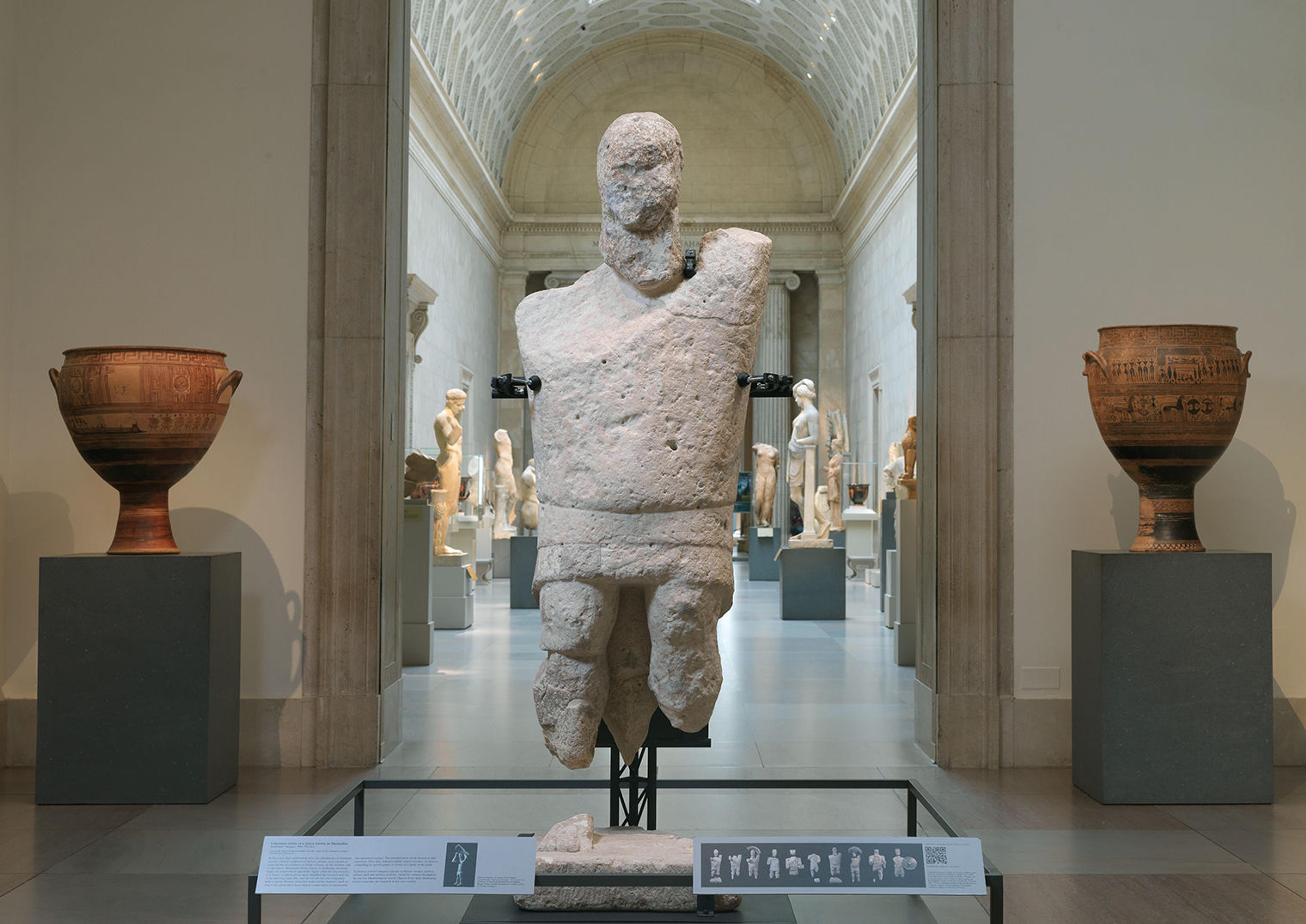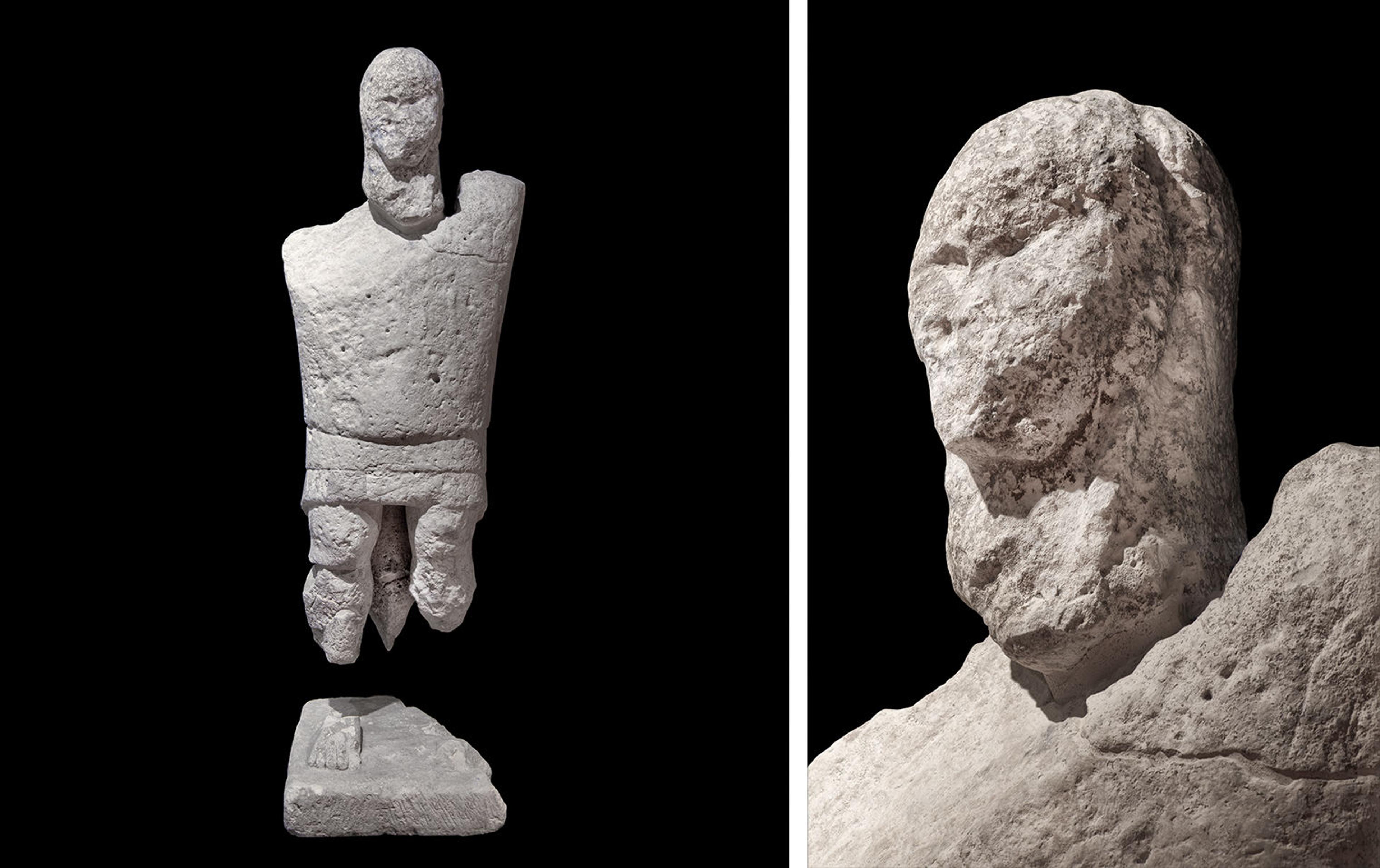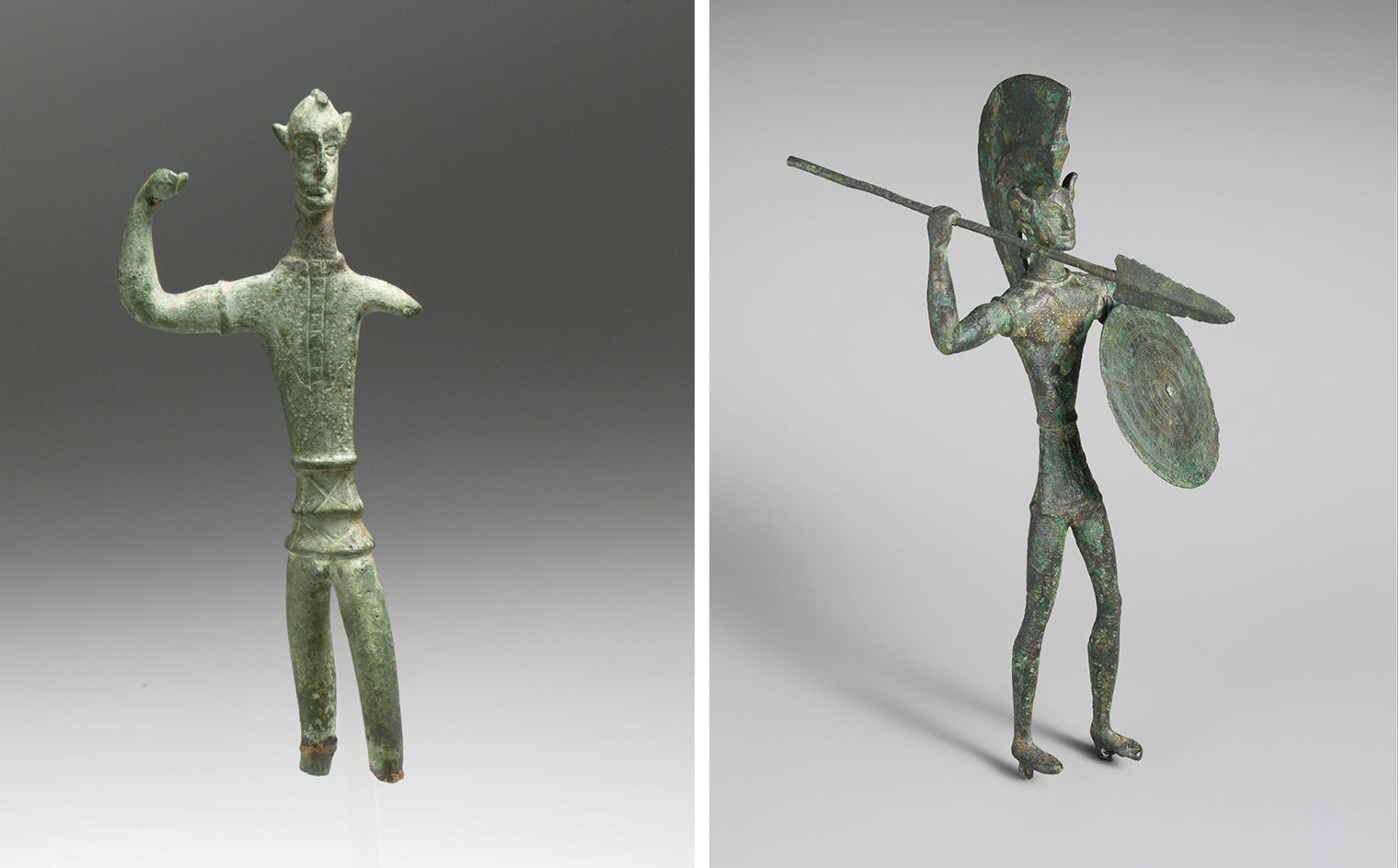
Installation shot of Mannedduu in The Met’s Greek and Roman galleries
In the early first millennium BCE, the Nuragic culture on Sardinia, named for the prehistoric stone towers called nuraghi still visible in the landscape today, erected dozens of monumental limestone sculptures in a necropolis, or funerary area, at the foot of a low hill called Mont’e Prama “the mountain of palm trees” on the western side of the island. The Department of Greek and Roman Art is pleased to display a colossal statue of a boxer from this group as a six-month loan from the Mont’e Prama Foundation, with the support of the Autonomous Region of Sardinia. Manneddu (from mannu in Sardinian, meaning large), as he was named when he was reconstructed, is one of the many enormous sculptures—some as tall as seven feet—known as the Giants of Mont’e Prama. Manneddu is the first Giant to be exhibited in the United States and offers visitors the rare opportunity to experience this little-known ancient culture, which is not represented at all in The Met’s collection.

Limestone boxers, archers, and warriors excavated from the necropolis at Mont’e Prama (Manneddu fourth from the right). Courtesy Mont’e Prama Foundation Archives, photo by Nicola Castangia
So far twenty-eight Giants have been reassembled, as well as sixteen sculptures representing nuraghi models. The figures represent boxers, archers and warriors in varying states of preservation. The largest number of statues reconstructed so far are the boxers like Manneddu, who wear a spiked glove on one hand and hold a rectangular curved shield above their heads. Their actual interpretation is still uncertain. They may represent lightly armed warriors, equipped for close combat, striking with the armored fist and protecting themselves with their shields, or athletes competing in sacred, yet bloody, games in honor of a deity or the dead.

Limestone statue of Manneddu, from the necropolis at Mont’e Prama, 900–750 BCE. Sardinian, Nuragic. Limestone, H. 77 ¼ in. (1.96m). Right: Detail of Manneddu’s head. Both images courtesy Mont’e Prama Foundation Archives, photos by Nicola Castangia
Manneddu is the largest of the reconstructed Giants. He appears bare-chested, wearing only a cap and a short garment that is held up by a belt. His eyes, formed from concentric circles, are only slightly visible on his worn face. His raised left arm, of which only the shoulder is preserved, originally held a shield, and the forearm and hand of his missing right arm were once sheathed in a glove with a projecting point. The remains of his right foot survive on a flat, rectangular base. Many details missing in the reconstruction of Manneddu are known from the better-preserved boxers and from comparison with bronze statuettes of the same date that have similar features.

Left: Bronze statuette of a boxer from Dorgali, Cala Gonone, 9th century BCE. Sardinian, Nuragic. Bronze. National Archaeological Museum of Cagliari. Courtesy Mont’e Prama Foundation Archives, photo by Nicola Castangia. Right: Bronze statuette from the tomb of Cavalupo at Vulci, Italy, 9th century BCE. Sardinian, Nuragic. Bronze. Courtesy National Etruscan Museum of Villa Giulia
Sardinian bronze statuettes of the ninth to seventh centuries BCE have been invaluable in reassembling the monumental statues, as they reproduce the same figural types, such as the boxer from Dorgali, Sardinia above. Few of the bronze statuettes come from known findspots, but those that do seem to have served as offerings to deities in sanctuaries. Remarkably, a Sardinian bronze figure of another boxer type known from the Mont’e Prama statues, with the shield held vertically alongside the body, was discovered in the Etruscan tomb of Cavalupo at Vulci in Italy, indicating the close interaction between cultures in Sardinia and Italy in this period.

Left: Bronze statuette of a warrior, late 6th-early 4th century BCE. Archaic, Etruscan or Italic. Bronze, 6 3/8in. (16.2cm). The Metropolitan Museum of Art, New York, Purchase, 1896 (96.9.428). Right: Bronze statuette of a warrior, 5th century BCE. Etruscan, from Populonia. Bronze, H. 10 3/16 in. (25.9 cm). The Metropolitan Museum of Art, New York, Bequest of Walter C. Baker, 1971 (1972.118.53)
The warrior imagery found in Sardinian sculpture and small bronzes alludes to heroic virtues, such as skill in battle or athletic competition, reflecting the values of power and social status that are found in many cultures throughout the ancient Mediterranean world. A case in the Greek and Roman galleries on display near the Giant features a selection of works from The Met’s collection that illustrate this ideology, focusing in particular on cultures in central Italy. These objects include a ninth-century BCE Villanovan bronze helmet, Etruscan and Umbrian bronze warrior statuettes of the late sixth to fourth centuries BCE (shown here), and fifth- and fourth-century BCE Etruscan miniature armor.
The Giant Boxer from Mont’e Prama is on view at The Met Fifth Avenue in Gallery 150 from May through December 2023.